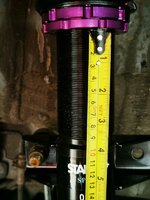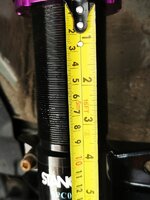You can do them all individually, indeed you can do them all different heights if you feel the need (This is the basis of 'Flat Flooring' only the adjustments are made with each wheel on a scale so the corner weights can be seen and adjusted via the spring loadings) but you may have problems getting the rears into a place where the spring tension has been released enough to allow the collar to be moved without having both wheels off the ground at the same time, 1) for the dampers to be unbolted at the bottom to allow the suspension arm to drop far enough to release the spring, 2) for the anti roll bar to not be under tension and make 1) difficult to achieve
The front wheel (or should I say Body) height is almost a direct one to one ratio, the amount you lower the spring collar is pretty much how much you lower the body, the spring bottom mount is almost at the end of the suspension arm so the hub is close to where the spring acts upon.
The rear adjustment is off by some margin due to the spring location being inbetween the hub and the fulcrum point of the suspension arm mount, you need to reduce the amount of turns on the rear spring collar relative to the amount you have turned the front collars to achieve the desired height.
Set the rears first then it's easy to adjust the fronts to get the same gap, not so easy the other way round, but be aware any loading in the rear will drop the rear gap more so than the front so you may have to raise the rear height when empty to account for carrying a load and having the van look right when it is doing so.






